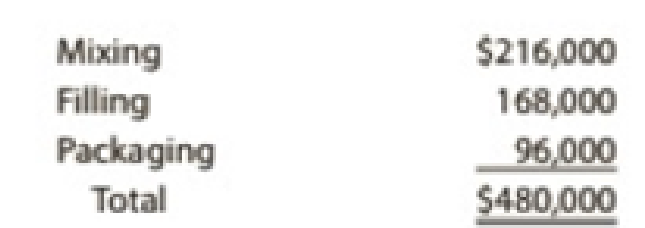
Concept explainers
Process activity analysis
The Brite Beverage Company bottles soft drinks into aluminum cans. The manufacturing process consists of three activities:
- 1. Mixing: water, sugar, and beverage concentrate are mixed.
- 2. Filling: mixed beverage is filled into 12-oz. cans.
- 3. Packaging: properly filled cans are boxed into cardboard “fridge packs.”
The activity costs associated with these activities for the period are as follows:

The activity costs do not include materials costs, which are ignored for this analysis. Each can is expected to contain 12 ounces of beverage. Thus, after being filled, each can is automatically weighed. If a can is too light, it is rejected, or “kicked,” from the filling line prior to being packaged. The primary cause of kicks is heat expansion. With heat expansion, the beverage overflows during filling, resulting in underweight cans.
This process begins by mixing and filling 6,300,000 cans during the period, of which only 6,000,000 cans are actually packaged. Three hundred thousand cans are rejected due to underweight kicks.
A process improvement team has determined that cooling the cans prior to filling them will reduce the amount of overflows due to expansion. After this improvement, the number of kicks is expected to decline from 300,000 cans to 63,000 cans, thus increasing the number of filled cans to 6,237,000 [6,000,000 + (300,000 − 63,000)].
- A. Determine the total activity cost per packaged can under present operations.
- B. Determine the amount of increased packaging activity costs from the expected improvements.
- C. Determine the expected total activity cost per packaged can after improvements. Round to three decimal places.
Trending nowThis is a popular solution!

Chapter 27 Solutions
FINANCIAL & MANAGERIAL ACCW/CENGAGENOWV
- Can you please help me by providing clear neat organized answers. Thank you!arrow_forwardCan you please help me by providing clear neat organized answers. Thank you!arrow_forwardSummary: You will investigate a case of asset theft involving several fraudsters for this assignment. The case offers a chance to assess an organization's corporate governance, fraud prevention, and risk factors. Get ready: Moha Computer Services Limited Links to an external website: Finish the media activity. The scenario you need to finish the assignment is provided by this media activity. Directions: Make a four to five-page paper that covers the following topics. Management must be questioned by an auditor regarding the efficacy of internal controls and the potential for fraud. A number of warning signs point to the potential for fraud in this instance. List at least three red flags (risk factors for fraud) that apply to the Moha case. Sort them into three groups: opportunities, pressures/incentives, and (ethical) attitudes/justifications. Determine which people and organizations were impacted by Moha Computer Services Limited's enormous scam. Describe the fraud's financial and…arrow_forward
- Coarrow_forwardCritically assess the role of the Conceptual Framework in financial reporting and its influence onaccounting theory and practice. Discuss how the qualitative characteristics outlined in theConceptual Framework enhance financial reporting and contribute to decision-usefulness. Provideexamples to support your analysis.arrow_forwardCritically analyse the role of financial reporting in investment decision-making,emphasizing the qualitative characteristics that enhance the usefulness of financialstatements. Discuss how financial reporting influences both investor confidence andregulatory decisions, using relevant examples.arrow_forward
 Managerial AccountingAccountingISBN:9781337912020Author:Carl Warren, Ph.d. Cma William B. TaylerPublisher:South-Western College Pub
Managerial AccountingAccountingISBN:9781337912020Author:Carl Warren, Ph.d. Cma William B. TaylerPublisher:South-Western College Pub Financial And Managerial AccountingAccountingISBN:9781337902663Author:WARREN, Carl S.Publisher:Cengage Learning,
Financial And Managerial AccountingAccountingISBN:9781337902663Author:WARREN, Carl S.Publisher:Cengage Learning, Cornerstones of Cost Management (Cornerstones Ser...AccountingISBN:9781305970663Author:Don R. Hansen, Maryanne M. MowenPublisher:Cengage Learning
Cornerstones of Cost Management (Cornerstones Ser...AccountingISBN:9781305970663Author:Don R. Hansen, Maryanne M. MowenPublisher:Cengage Learning Managerial Accounting: The Cornerstone of Busines...AccountingISBN:9781337115773Author:Maryanne M. Mowen, Don R. Hansen, Dan L. HeitgerPublisher:Cengage Learning
Managerial Accounting: The Cornerstone of Busines...AccountingISBN:9781337115773Author:Maryanne M. Mowen, Don R. Hansen, Dan L. HeitgerPublisher:Cengage Learning



